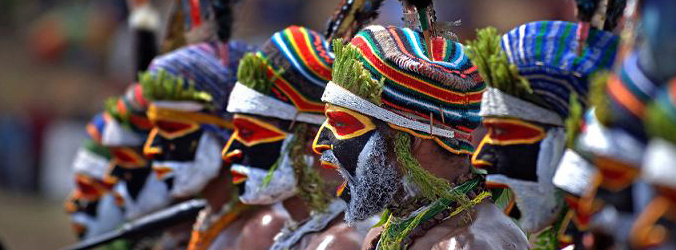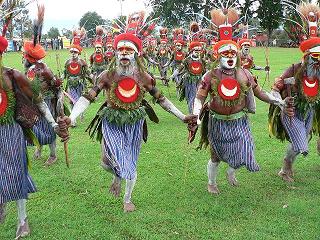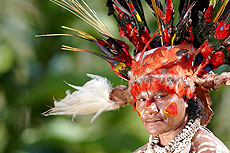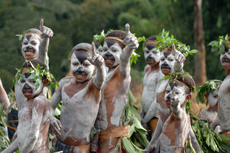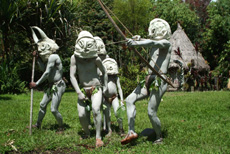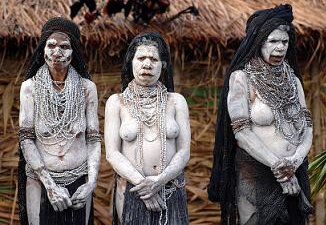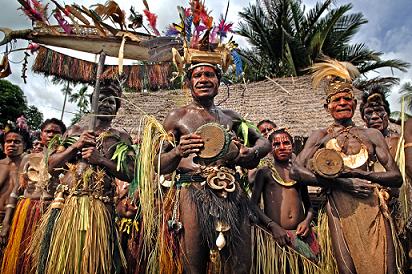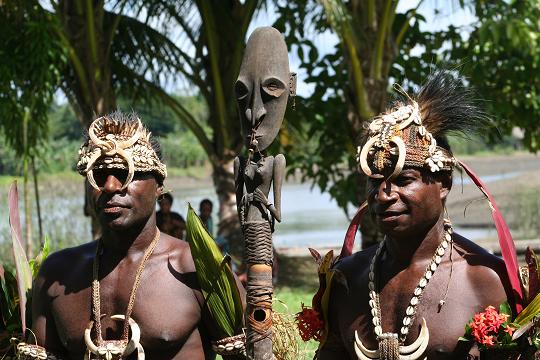Mount Wilhelm Traverse 2025
Mount Wilhelm Traverse
Highlights:
· Climb Papua New Guinea’s highest Mountain via the challenging Ambullua route
· Enjoy panoramic views of the Jimi Valley, Bismarck Range, and North Coast
· Discover the village of Ambullua, an authentic cultural experience in a remote and traditional highland village
· Trek through tropical mossy forests, alpine grasslands and past moraine lakes.
Overview:
Korel Khu (Mt Wilhelm) is Papua New Guinea’s highest mountain at 4509m/14,793ft. In this trek we approach the mountain from the Jimi Valley, an isolated and spectacular valley. Starting in the picturesque village of Ambullua we will experience the traditions and hospitality of the local people. From Ambullua the ascent takes us across raging rivers, through mossy forests, into spectacular alpine grasslands, and through glaciated valleys. After summiting we descend via the better-known route from Simbu. There are very few people who have walked the amazing Mount Wilhelm Traverse from Ambullua to Keglsugl.
This traverse could also be combined with the Mount Giluwe trek. Mount Giluwe is to the west of Mount Hagen and is the highest volcanic summit on the techtronic Australasian plate or other tours listed on this web site
The Highlands of PNG experience rain throughout the year and it is possible to climb Mount Wilhelm at any time throughout the year, however it is typically dryer from May to October.
SUMMARY– 8 DAYS / 7 NIGHTS
1 night - Rondon Ridge, Mount Hagen
1 night - Korel Khu Guest House
1 night - Augol Tungi Camp.
1 night - Hkelip Camp
1 night - Seeku Camp
1 night - Lake Piunde Hut
1 night - Rondon Ridge, Mount Hagen
BRIEF ITINERARY
1st July
Upon arrival in Port Moresby, Trans Niugini Tours staff will greet you for your onward flight to Mount Hagen. Upon arrival in Mount Hagen, you will be met and transferred to Rondon Ridge where you will meet other group members and the group leader..
Overnight: RONDON RIDGE (D)
2nd July
Early morning departure from Mount Hagen for Ambullua. We travel by 4WD for approximately 120km (6 hours) to Kol through the Banz Gap. Views into the Jimi Valley between the Banz Gap and Kol are spectacular. The road also has creek crossings and passes waterfalls. From Kol we continue as far to Ambullua as the road conditions will allow. When the road becomes impassable (where that happens depends on a variety of factors) we will complete the rest of the journey to Ambullua by foot.
Overnight: KOREL KHU GUEST HOUSE (BLD)
3rd July
We begin the ascent. The first hour or so is through sweet potato gardens until the Korel River. After crossing the river the path then continues next to the river and through more gardens, before turning up a spur. The spur is a steep ascent through the mossy forest for a number of hours. We continue and overnight at Augol Tungi, a small clearing in the forest, atop the spur. At Augol Tungi trekkers have the choice of staying in small traditional huts or pitching a tent.
Overnight: AUGOL TUNGI (BLD)
4th July
Picking up where we left off the previous day, we continue up the spur through the mossy forest for a further couple of hours. After crossing a creek (where the adventurous can have a dip) we enter the alpine grasslands where spectacular views down towards Ambullua and the Jimi Valley await. We continue upwards towards Hkelip, a small saddle that offers good protection, and easy access tor fresh water.
Overnight: HKELIP (BLD)
5th July
After a relatively short climb to the top of a ridge, much of the day is spent walking along it, undulating from knoll to knoll. Aside from spectacular views all around, we get our first look at the summit. Eventually we drop down into a valley. The path gives wonderful views of the lake Korel Erum. We work our way up the valley to an area called Seeku, which gives a relatively flat camp site and shelter for our porters.
Overnight: SEEKU (BLD)
6th July
We will plan to depart a few hours before dawn, heading up the valley towards the summit massif. When we get to the end of the valley, the path turns upwards and is very steep. Eventually the grass gives way to just stone, which is loose and brittle and involves some scrambling. We eventually reach a small saddle. From there we continue and eventually join the Simbu route for the final push to the summit. All going to plan, we will be sitting atop the tallest peak in Papua New Guinea watching the sun rise over the Pacific Ocean. The distant volcanic Kar Kar Island standing proud. We then continue down the standard route, past a WWII American B-17 Bomber to Lake Piunde where we will stay in a hut.
Overnight: LAKE PIUNDE (BLD)
7th July
Continuing down the Simbu route for a few more hours, we arrive in the village of Keglsugl. We then travel by 4WD down the spectacular Chimbu Gorge and travel back to Mount Hagen.
Overnight: RONDON RIDGE (LD)
8th July
Transfer to your onward flight or to another trek.
RONDON RIDGE (B)
*************End of arrangements*************
What to expect:
· Trip leader
The trip will be led by Michael Bates, one of the original expeditioners who pioneered the Ambullua Route in 1998. Michael grew up in the highlands of PNG, speaks fluent Tok Pisin and has climbed Mt Wilhelm over 10 times, as well as other challenging peaks around Papua New Guinea. Michael is also an Australian champion free diver and in recent years has been leading groups of free divers to PNG. When he’s not trekking or free diving, Michael also likes to ride bicycles– from BMX to Road bikes.
· Weather
The weather patterns of the Bismarck Range are characterised by a daily, rather than seasonal, cycle. Having said that, being the austral winter July has, on average, a little less precipitation and is slightly cooler than other times of the year. Overnight temperatures at Hkelip and Seeku can drop below freezing and overnight snow occasionally falls on the summit.
Early mornings are often clear in the mountains and foggy in valleys. Cloud usually builds up in the mountains throughout the morning and there is typically rain by mid-afternoon, which is frequently heavy. We usually aim to get moving as soon as practical and establish camp by early afternoon.
· Trekking conditions
You should plan on carrying a small day pack with personal items in it (e.g.camera, snacks, additional clothing, rain jacket, water bottle, valuables, and other personal items such as sun screen). Local porters will carry your main pack, as well as group equipment.
The frequent rain and humid conditions mean that the path is often wet and slippery. Sturdy shoes with a good grip are recommended.
The path is very steep on occasion. No technical equipment or knowledge is required, but you should be prepared to scramble in places.
· Camping conditions
Given the high levels of precipitation, the ground is usually very wet. We use tents with heavy floors or ground sheets to help prevent water from soaking through.
Most of the campsites are basic with only a small areas, which can be a little uneven in places - a good quality sleeping mat is recommended. This combined with the typical weather means that a fair proportion of the afternoons and evenings are spent in tents. So, bringing games or reading material is suggested.
· Mountain sickness
Due to the altitude of the Wilhelm traverse, mountain sickness is common. The only cure to mountain sickness is to descend. Communicate with the group leader if you believe you are experiencing mountain sickness symptoms so that you can monitor the symptoms together. If symptoms are acute, you may be required to descend. We have logistics in place for this eventuality.
· Essential gear
o High quality rain-wear/outer shell
o Warm clothing that will still provide warmth even if wet
o Clothing that provides good sun protection
o Sturdy trekking boots/shoes
o Blister and personal first aid kit
o Games/reading material for rainy afternoons
o A comfortable air mattress for sleeping (e.g.thermarest)
o Head torch with spare batteries
o Suitable sleeping bag (nights in some camps can be below freezing)
o Day pack (carried by you)
o Back pack (carried by porters)
o Water bottles with sufficient capacity to get through a day of walking
Land Cost Per person
Twin Share @ AUD$3,799.00 per person
What’s included?
· 7 nights/8 days of accommodation on a twin share basis.
· Meals as indicated
· Group equipment, including tent (sleeping bag and mat not included)
· Experienced leader, guides, and cook
· Porters to carry personal and group equipment
· Airport transfers in Mt Hagen
· Vehicle transfers from Mt Hagen to Kol and Keglsugl to Mt Hagen
· Flight to flight transfers in Port Moresby
What’ not included
· International and domestic flights
· Sleeping bag and mats
· Beverages
· Items of a personal nature
· Visa
· Travel insurance (compulsory, including evacuation insurance)
Important Note:
Domestic and international flights are not included in the cost and we do not arrange these. You are to book and ticket the domestic Air Niugini flights together with your international flights.
Air Niugini (PX) Domestic Flights:
1st July PX186 or PX188 - Port Moresby to Mt Hagen
8th July PX181 - Mt Hagen to Port Moresby
For further information please contact us
..................................................



